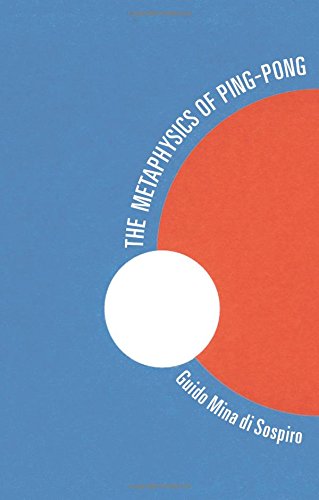 Reviewed by Justin Goodman
Reviewed by Justin Goodman
The Metaphysics of Ping Pong
by Guido Mina di Sospiro
Quest Books
Paperback: 240 pages, September 1, 2015, ISBN-13: 978-0835609425
It was after hours and I felt my behavior was shadowy (ignoring that my parents had driven me back). For a brief time, once a week, Newfield High School would have after-hours game night. More than awkwardly watching boys twice my height and twice as fit dunk and chest bump—that they were the basketball team and had formed the clique natural to sports only added to my shadow sense—and more than talking to my equally unfit friends about whatever it was we found important back then, I remember waiting for table tennis to open up. It’s one of those outcast sports treated with disdain, along with table football, as if belonging to only children. It doesn’t help that their professional names are equivalent to a dollhouse, a shrunken version of seriousness marketed to children, nor that their casual names sound like the product of a childish mind: ping pong, foosball. But if you’re a fan of The Secret World of Arietty, or Miyazaki in general, you’ll understand that a dollhouse can be a place where unsettling maturity happens. Agog at the wondrousness of being unsettled, Guido Mina di Sospiro recounts his journey towards self-discovery in his departure from fiction, the philosophical memoir, The Metaphysics of Ping-Pong.
The humility to which he begins his story is surprising given this title, starting with a simple, “my full-blown obsession with ping-pong began four years ago with the semi-epic road trip.” From the there the story follows a surprisingly human pattern: Beaten by son (at ping-pong), age begins to show (as blood pressure), attempts to reclaim youthfulness (or, at least, not die). This lasts a very brief time. Di Sospiro can often be didactic and doubly left-footed—proved as much with his yew tree narrator’s boring mysticism in The Story of Yew—and, though he can be gentle to the reader, his excitement more often becomes overwhelming. That’s not to say his references to the Greek philosopher Plato, Chinese ping-pong champion Wang Hao, French poet Paul Valery, or Dutch historian Johan Huizinga become muddled when combined with his various other references. It’s a clean network of ideas. But, from what Di Sospiro calls a “western perspective,” saying “once a player finds true form [the Platonic Ideal], victory comes with it as a mere corollary” sounds like watery-eyed absurdity.
That, I suppose, is the point. From the moment di Sospiro mentions his friend Rupert Sheldrake, “the controversial philosopher of science,” skepticism begins to shadow every saccade. Sheldrake, mind you, suggests that memory is inherited (a process he calls “morphic resonance”). Seen largely as pseudoscience, this Jungian theorizing can unnerve a Western reader raised on hard science and materialism. And while the appropriation of scientific and mathematical concepts like Non-Euclidean is a questionable practice, the very arc of The Metaphysics of Ping-Pong—
From America to China, Scientific to spiritual terms, begrudged defeat to humble victory—attempts to push away from this conceptualization anyway, towards “transcend[ing] mere learning.” Hence his succinct distinction between the two styles of ping-pong players (and lifestyles): Metaphysicians who “take life head on and yearn to get as close as possible to true form,” and Empiricists who “take the easy path and don’t strive at all.”
Besides the pretentious hand waving away an entire branch of thought with one superbly painterly stroke, ironically, this is the largest flaw of the memoir. By compounding reference upon reference, by constantly referring to etymology as support for an idea, he is simply a learned man. Yes. He displays humility towards the reader about his knowledge of ping-pong. That doesn’t prevent him, however, from condescending by creating a chest puffing distinction opposed to the ideal of the “wordless, pure meditation.” Of course, that’s casting aside the generally flippant and belittling approach to women throughout the book that blend together in a mixture of “fine-looking,” “particularly good looking,” and “flirtatious (perhaps as a strategy to distract).” It goes on.
Surprisingly, di Sospiro manages to write in a way that’s approachable and sometimes clever. By all definitions an interesting approach to a sports memoir, and should be held with pride as the first in the sport. I say that having shivered with uncomfortable familiarity at his bravado and sly self-adulation that brought me back to those days at Newfield when I would hear other boys brag about a victory, or sex, or those other subjects which fill the locker room with its familiar stench. I have heard them recount an exploit with the zest of a war story, filling their balloons with the helium of others saying “’you’re really good,’ and smile in awe” until they’re ego floats off, them shouting that “with such a strong bias against western players, I’m the eternal surprise.” In de Sospiro’s defense, China has dominated the sport since the ‘90s. But, according to him, “proficiency is not the ultimate goal.” The goal “In ‘humble’ table tennis [is to] be looking for the living presence that informs the phenomenal world.” His phenomenal world of air quotes around humility.
About the reviewer: Justin Goodman graduated from SUNY Purchase with a B.A. in Literature. Having moved from Long Island, he now lives in the City with reviews in Cleaver Magazine and InYourSpeakers, and work in Italics Mine, 360 Degrees, and Counterexample Poetics.